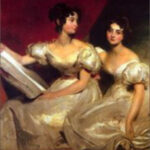James Gordon Brown (known as Gordon Brown) was born in Govan, a district of Glasgow on the 20th of February 1951, the second son of Rev Dr John Ebenezer Brown and Jessie Elizabeth Brown nee Souter. When he was three years old, the family moved to Kirkcaldy in Fife, where his father was the vicar of the town.
Gordon Brown’s father John Ebenezer Brown, was the son of a shepherd, who despite poverty won a place at St Andrew’s University, where he studied Divinity, and then Hebrew and systematic theology. He was then ordained a minister and wrote several theological books as well as looking after his parish. However, Gordon’s mother, Jessie Elizabeth Souter, came from decidedly middle class stock. Her father owned a timber, building and general goods business, John Souter Ltd, which was founded in 1898 and employed up to 70 people and did well enough for John Souter to ensure his daughter was privately educated. She was bright and mathematically inclined and during World War II worked as a military code breaker in London.
In 1947, she married John Ebenezer Brown and settled down with him, ministering to his flock. John Ebenezer Brown took his duties seriously. He would receive his parisioners any time of day or night, and frequently handed out food and cash to the needy. It’s speculated that the money for the handouts came from Jessie Elizabeth, who remained a silent director of her father’s company and received an income from it.
Gordon Brown was a gifted child, and his school Kirkcaldy High, (the school Adam Smith, author of The Wealth of Nations, had studied at nearly 300 years earlier), fast-tracked him. Kirkcaldy High was a state school when Gordon Brown attended, and was taking part in a post war hothousing experiment to get their best and brightest to university. The hothousing meant that Gordon Brown was accepted at the University of Edinburgh at just 16 years old.
It was while at university that the first set-back of his life occured. After being kicked in the head during a rugby union game, he suffered retinal detachment in his left eye. They were unable to save it, in spite of repeated operations, and he lost sight in that eye. A few months later the same symptoms appeared in his right eye, and while surgeons managed to save it, vision was impaired. To this day, Gordon Brown has trouble with the sight in his remaining eye – he is unable to drive, being classed as legally blind, and writes his memos in giant black writing. One aide reports that he send memos to Brown in 36 point so that Brown is able to read them himself without getting an assistant to read them for him.
Despite the setbacks, Gordon Brown graduated from Edinburgh University with a First Class Honours MA in History, and then stayed on to do his PhD. It was while at Edinburgh he got his taste for politics, winning his first election as Rector of the University. After graduating, he worked as a lecturer in Politics for Glasgow College of Technology, and then as a journalist for Scottish Televsion.
He was elected to Parliament in 1983, becoming Labour MP for Dunfermaline East, and immediately became a shadow cabinet minister for Trade and Industry. At that time the Labour party was in the doldrums after suffering one of the worst defeats in it’s history at the hands of Margaret Thatcher’s Conservatives. Gordon Brown and his friends Peter Mandelson (at the time not yet in parliament), John Reid MP, and Douglas Henderson, union leader (and later MP), founded New Labour, a movement that was on the right of the Labour party and determined to reform it. The four men decided to invite a fifth man into their movement, one Tony Blair MP, who had been elected in the same year as Gordon Brown and shared offices with him, in the process becoming best friends.
At this point, Gordon Brown was the leader of this pressure group. Blair was very much the junior partner who had been invited along to participate in this noble cause. Both men were eyed favourably by Neil Kinnock, who had been elected leader of the Labour party and was trying to make it electable. Despite the fact that both Brown and Blair were only in their early 30’s, they were given plum roles in the shadow cabinet, and allowed to shine. Labour gained seats in both the 1987 elections and the 1992 elections, but seemed unable to make the breakthrough to victory. Neil Kinnock resigned and John Smith was elected leader. The New Labour project suffered a setback under Smith, as he appeared to believe that no further reform was necessary, to the frustration of Blair and Brown.
However, in 1994, John Smith unexpectedly died of a heart-attack, and the leadership was up for grabs. Because there would be candidates from the old left of the party (Margaret Beckett and John Prescott), it was considered vital that New Labour fielded only one candidate, so as not to split the vote. Both Blair and Brown wanted the job, but power titled to Blair when Peter Mandelson decided that Blair would be more likely to win votes from Middle England. A famous meeting took place between Blair and Brown at the Granita restaurant, about which there is much speculation. At the meeting, Brown is supposed to have agreed to step aside from the leadership contest as long as Blair allowed him free reign as Chancellor of the Exchequer, and then stepped down after two terms to allow Brown the premiership. Blair afterwards denied that he’d made any promise to step down, though John Prescott in his autobiograophy asserts that he did. But “the deal” as it was known, caused much enmity in the heart of New Labour. Brown felt bitter towards his old friend Peter Mandelson for choosing Blair over him, and the constant battle over whether Blair had promised to step down poisoned relations between Blair and Brown.
Whatever the truth, Gordon Brown did become the most powerful and autonomous Chancellor of the Exchequer in post war history. The day after the 1997 election, Brown made the Bank of England independent, and then presided over ten continuous years of growth as chancellor even while countries such as the USA went into recession in 2001, along with Japan and Germany. And while there were constant reports in the press about tensions between Blair and Brown over various issues (most notably the euro, which Blair wanted to join but Brown opposed), the two men continued to work together.
In 2000, Gordon Brown married Sarah MacCauley. Their first child Jennifer, was born prematurely and died after 8 days. They then had a healthy son John, and then another son, James Fraser, who was diagnosed with cystic fibrosis.
In the autumn of 2004, Blair, who had been suffering heart problems, announced that while he would contest the 2005 election, he would not serve a full term, but would step down in the following parliament. The 2005 election saw Blair and Brown tour the country together, in a two-fer. The Conservatives had mocked up a poster saying “Vote Blair, get Brown” but ditched it when they realised the public liked the idea. However, once the election was over, Blair seemed to have second thoughts about stepping down, and his hand had to be forced by his party who were tired of his foreign adventures that always seemed to involve wars. In June 2007, Blair stepped down, and as no one stood against Gordon Brown for the leadership, he became leader of the Labour party and Prime Minister, as Labour held the majority of seats in the House of Commons.
Brown’s first months as Prime Minister were something of a honeymoon. All sorts of calamities occured; a terrorist attack in Glasgow, floods in middle England, foot and mouth disease in the farming community, and Brown coped with the crises well, earning approval from the public. But in autumn 2007, following feverish speculation about whether a general election would be called, he decided not to call one, to the disappointment of the press, who turned on him. Thereafter, he could do nothing right, and seemed to bungle policy after policy, with Labour falling back in the polls to the lowest since that disastrous general election in 1983. There was speculation that the Labour party would remove him as leader.
But at the party conference in September 2008, Brown fought back, giving a good speech, warning that in times of economic turmoil, “this is no time for a novice”. It was thought to be a jibe towards both the opposition leader David Cameron and to David Miliband, the Labour Foreign Secretary, whom some thought should replace Brown as leader. Brown followed up by reshuffling his cabinet, sensationally bringing Peter Mandelson back into government (Mandelson had been in Brussels as European Commissioner). It was a spectacular burying of the hatchet between the two founders of New Labour who had now decided to fight together to save the project and ensure Labour won another election.
The tide turned. When the October meltdown of the banking system and financial markets occured, Brown earned plaudits for his decisive action, with Paul Krugman writing in the New York Times, “Has Gordon Brown, the British prime minister, saved the world financial system?. Labour moved back up in the polls, within striking distance of the Conservative party.
It’s too early to say whether Brown’s actions have saved the economy or whether he will win a general election (which has to be held by May 2010 at the latest). But whatever happens, Gordon Brown will be remembered for two things: making the Bank of England independent and for the actions he took in the financial panic of 2008, when he led the world.




